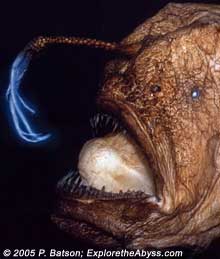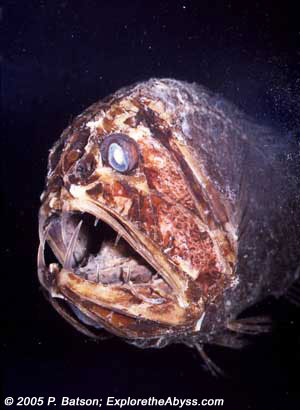Life in the Deep
Many species of deep ocean fish have special adaptations to living in extremely high pressure, low light conditions. Viper fish(Mesopelagic - found at 80-1600 meters - about a mile down) are some of the most wicked looking fish dredged up from the depths. Some of them are black as night all over with light organs (calledphotophores) in strategic places on their bodies, including one on a long dorsal fin that serves as a lure for the fish it preys upon. Some viperfish (and many other deep ocean fish species) don't have anypigment (color) at all - they're "see through". They also have enlarged eyes, presumably for gathering as much light as possible where there is little or no light at all. The light organs create lights by using a chemical process called bioluminescence. Other deep ocean fish, such as the the gulper eel
have a hinged skull, which can rotate upward to swallow large prey. They also have large stomachs which can stretch to accommodate a fish much larger than itself. The gulper eel is particularly well-known for its impossibly large mouth - big enough to get its mouth around (and swallow!) creatures much bigger than itself. Fish that live down here must adapt to a very low food supply, eating only "scraps" that sink down from above, or sometimes eating each other.
Here's an up close and personal view of the wicked-looking Viper fish (Chauliodus macouni). Check out the teeth and the bug eyes on this guy! Click on the photo to see a much larger picture...
(photo courtesy of Paul Yancey,
Biology Dept., Whitman College,
Walla Walla Washington)

A Fangtooth - scientists still aren't exactly sure why so many bony fishes of the deep have such enlarged, daggerlike teeth.
No comments:
Post a Comment